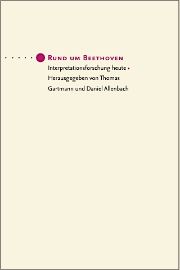Questions of interpretation
This publication by the Bern University of the Arts focuses on research into performance and interpretation traditions, with a particular focus on Beethoven.

The term "interpretation" requires interpretation. It can refer to performance practice, compositional reception, music criticism and even the analysis of a work that likes to present itself as objective and scientific. The anthology published by the Bern University of the Arts is therefore deliberately broad in scope All about Beethoven - interpretation research today. More than 500 pages and 30 essays offer thoughts and findings on such thorny questions as what Ludwig van Beethoven might have sounded like in the past, what Richard Wagner's conducting habits for the Ninth were like, and what creative compositional or music-theatrical appropriation was like.
There is a good answer as to why Beethoven is at the center of attention: of course, the anniversary plays a role. There is also a lot of material. This includes practical performance considerations from the 19th century, various editions of sheet music, as well as some very early recordings on Welte-Mignon or rival Hupfeld recording equipment. Manuel Bärtsch's observations of two interpretations of Beethoven's Piano Sonata in A major op. 101 are illuminating: one is a recording by Liszt pupil Eugen d'Albert on the Welte-Mignon reproduction piano, the other is Frederic Lamond's interpretation on the so-called Animatic roll by Hupfeld. The recordings, made around 1910, cannot be reconciled with an - apparently obsolete - concept of "faithfulness to the original". Rather, they give the impression of a joyfully playful appropriation of Beethoven, in which, as Bärtsch puts it, "remnants of tradition, inherent laws, creative appropriation and physical conditions are reflected". (S. 69)
It is to Bärtsch's credit that he does not conceal the problems of performance-oriented research. It is based on snapshots, shaped by particular situations (performers often took account of the technical shortcomings of the early equipment), divergent traditions and individual, subjective life histories. The advice of the conductor and pianist Hans von Bülow that a student should not use his, i.e. Bülow's, edition of the music speaks volumes: "But I advise you to take Klindworth's edition; there you will find all the good things in my edition, the superfluous eliminated, the erroneous improved." (S. 113)
With questions of interpretation in the sense of a "creative appropriation", authors push forward into the present. Michelle Ziegler deals with Mauricio Kagel's "rescue attempt in the anniversary year", i.e. with Kagel's thoroughly topical thoughts on the instrumentalization and appropriation of Beethoven on his 200th birthday in 1970. While Ziegler succeeds in giving a concise account of both the climate at the time and Kagel's thoroughly mocking and mischievous aesthetic, Simeon Thompson's more journalistic remarks remain nebulous. His topic is "Beethoven and the Second World War in the artistic reflection of the post-war period". The juxtaposition of Rolf Liebermann's 1952 Basel premiere of the opera Leonore 40/45 and the movie A Clockwork Orangewhich Stanley Kubrick brought to cinemas in 1972. In any case, the tenor seems to be that Liebermann trivializes the reception of Beethoven during the Second World War, while Kubrick is obviously more justified in addressing the violence in and around Beethoven.
Such questionable exaggerations are the exception in an anthology that makes a comprehensive contribution to the state of contemporary interpretation research. The edition by Edition Argus is exceptionally fine, and the editing of the texts, most of which originate from a symposium organized by the Bern University of the Arts in 2017, is more than thorough.
Around Beethoven. Interpretation research today, edited by Thomas Gartmann and Daniel Allenbach, 533 p., € 63.00, Edition Argus, Schliengen 2019, ISBN 978-3-931264-94-9, free PDF








